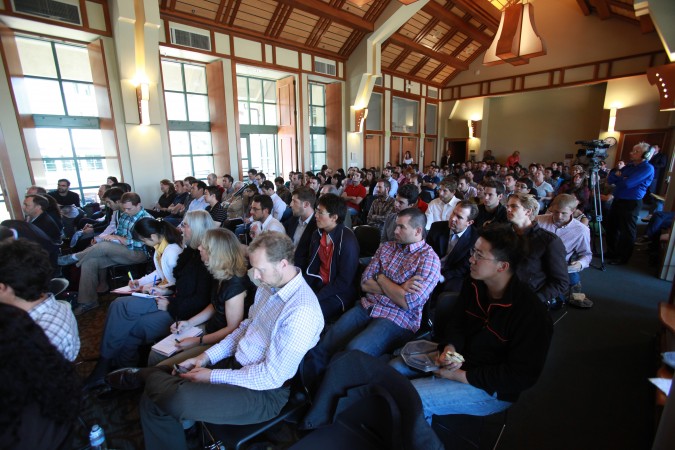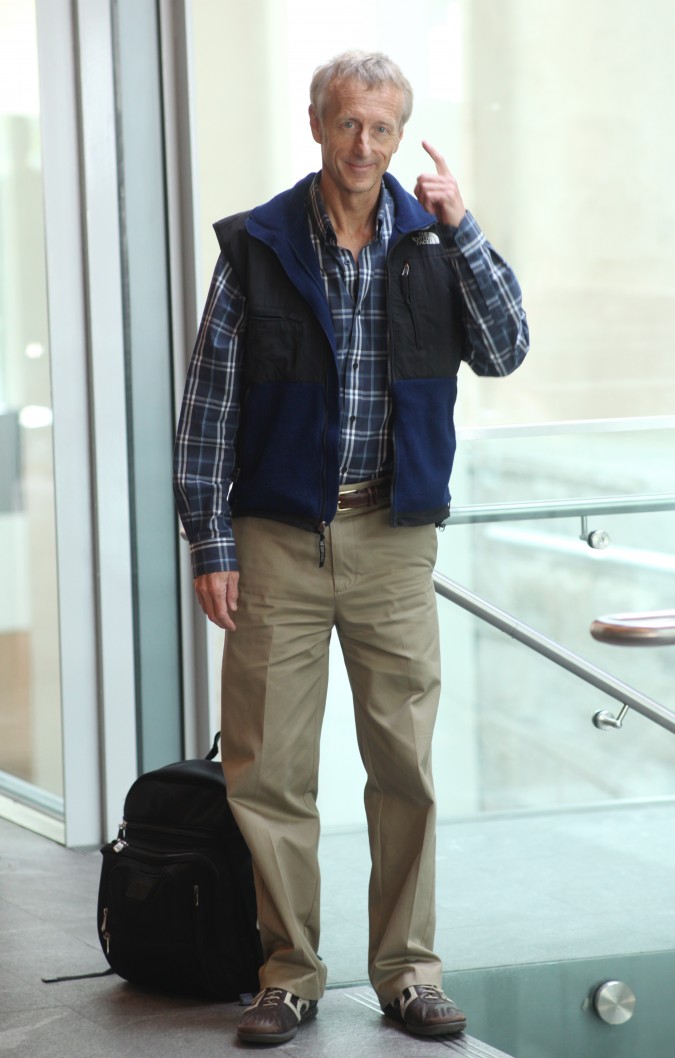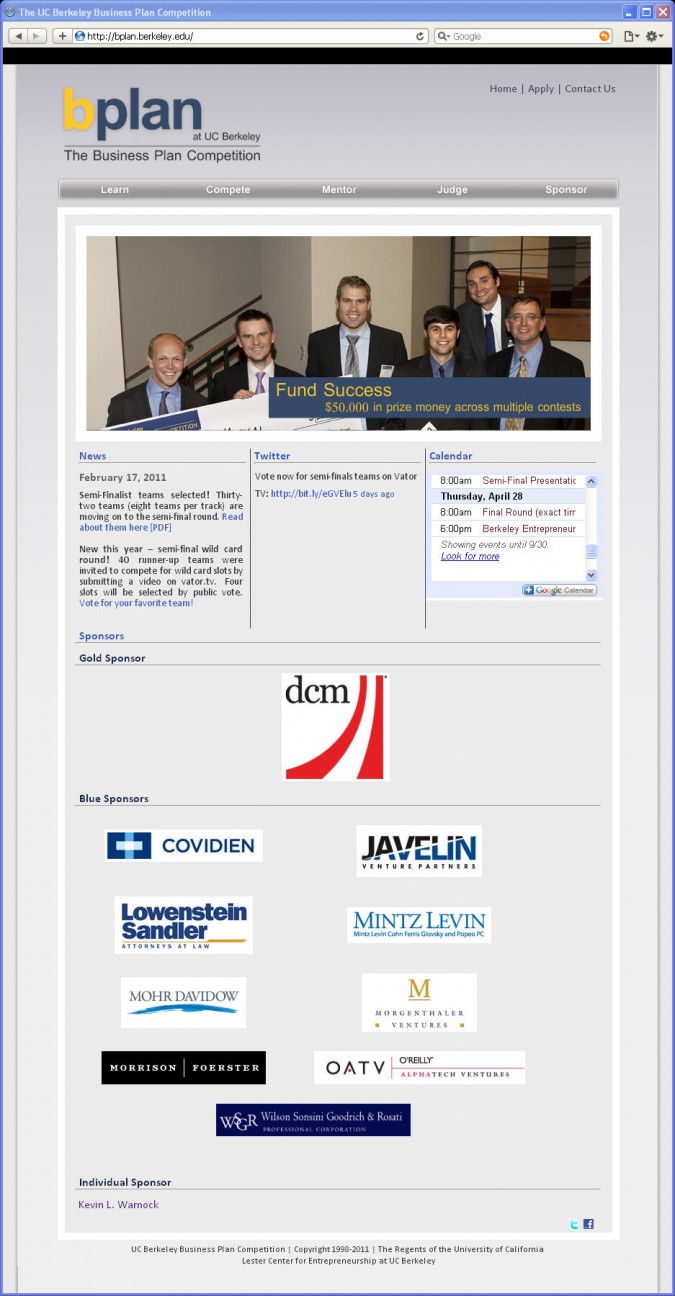Archive for the ‘berkeley business plan competition’ tag
AT&T CEO Randall Stephenson is interviewed September 6, 2012 by Rich Lyons, the Dean of the Haas School of Business at University of California Berkeley

Rich Lyons, Dean of the Haas School of Business at UC Berkeley interviews Randall Stephenson, the CEO and Chair off ATT, September 6, 2012. Photograph by Kevin Warnock.
On Thursday, September 6, 2012, I attended the Dean’s Speaker Series at the Haas School of Business at the University of California at Berkeley, in Berkeley, California USA.
This was the first Dean’s Speaker Series I have attended.
I have been aware of this series for years, but I assumed attendance was restricted to friends of the Dean, Rich Lyons, because of the name of the event.
I’ve met and spoken with the Dean about ten times over the years, I estimate, including when he was the Acting Dean when Dean Tom Campbell took a leave of absence to help then Governor Arnold Schwarzenegger manage the finances of the State of California.

Rich Lyons, Dean of the Haas School of Business at University of California Berkeley, asks Randall Stephenson a question, September 6, 2012. Photograph by Kevin Warnock.
A couple of weeks ago I was looking over the Haas website and marveled at the outstanding list of upcoming individuals the Dean will be interviewing on stage. There in front of me were the magic words — the events are open to members of the Haas ‘community.’ I was pretty sure I qualified, since I am a sponsor of one of the school’s premier events, the Berkeley Startup Competition, and have been every year since 2000. I inquired and I got a seat — I was and am thrilled.
The Dean’s guest for this event was Randall Stephenson, the Chief Executive Officer of AT&T, the largest telecommunications company in the United States.
I am an AT&T customer, both for my home’s broadband Internet connection and for my wireless Apple iPhone 3GS, which I bought soon after launch. I no longer have a wired phone. I like AT&T’s service — I get great reception and few dropped calls.
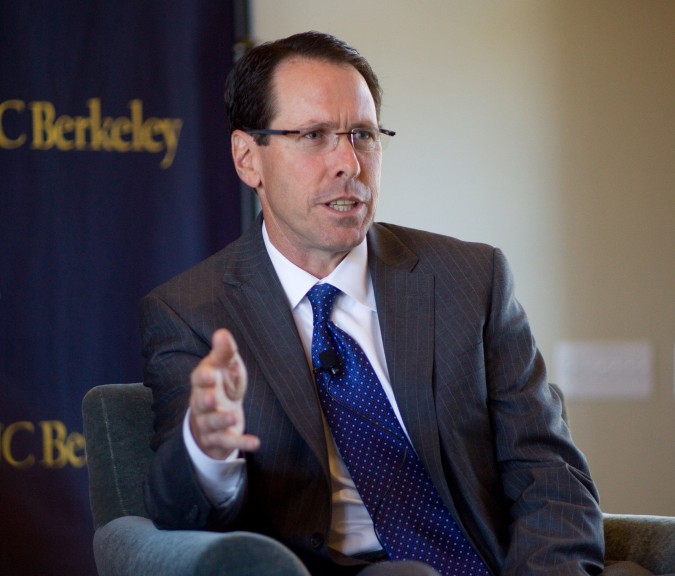
Randall Stephenson, Chair and CEO of AT&T, photographed by Kevin Warnock on September 6, 2012 at UC Berkeley
My regard for AT&T went up after listening to Stephenson speak for an hour. Stephenson was Chief Financial Officer and Chief Operating Officer prior to becoming Chair and CEO, among many roles.
He started at a job he called a ‘tape monkey’ at Southwest Bell Telephone in 1982 loading 19 inch diameter magnetic tapes of billing data onto tape drives. He did this work 12 hours a day — reading a video screen for instruction on which tape to load, finding the tape in storage, loading the tape and then pressing ‘Run.’
I did this same job, though not full time and not for 12 hours a day, when I worked at Cooley LLP. Thankfully I only had to do this role about two weeks a year, when the regular tape technician, Bill Calhoun, went on vacation.
Stephenson said he figured a way to rework his tape loading job to make it much more efficient and enjoyable, though he didn’t tell us the details of what he changed.

Rich Lyons, Dean of the Haas School of Business at University of California Berkeley, listens to Randall Stephenson answer a question, September 6, 2012. Photograph by Kevin Warnock.
During his introductory remarks, Rich Lyons said Stephenson worked in Mexico City as SBC’s Director of Finance.
At some point, Stephenson worked in Mexico for Carlos Slim, the iconic leader of Telmex. Stephenson did not explain how he came to work for Carlos Slim, who presumably was not an SBC employee at any point in his life.
Stephenson said Carlos Slim is ‘the most inherently brilliant individual that I’ve ever worked with.’
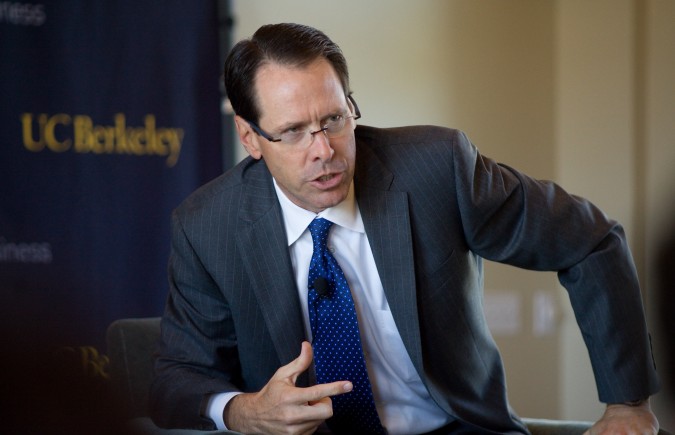
Randall Stephenson, CEO and Chair of AT&T, speaks at University of California at Berkeley, September 6, 2012. Photograph by Kevin Warnock.
Stephenson was in Mexico working for Slim in 1994 when there was an economic crisis that began December 19, 1994, when the Mexican government lifted all restraints on the Mexican Peso and let its value float. The Mexican currency lost 40% of its value in one day, Stephenson recalled.
Slim had 20,000 wireless subscribers in 1994, and thanks in part to the aggressive investments Slim made in the aftermath of the economic crisis of 1994, TelMex now has over 200 million wireless subscribers and Slim has made himself reportedly the wealthiest man in the world.
Stephenson took his job as CEO in June 2007 when ATT was a $100B annual revenue company with 300,000 employees, the same month that Apple launched its first iPhone. Stephenson invested heavily when the 2008 financial crisis came.
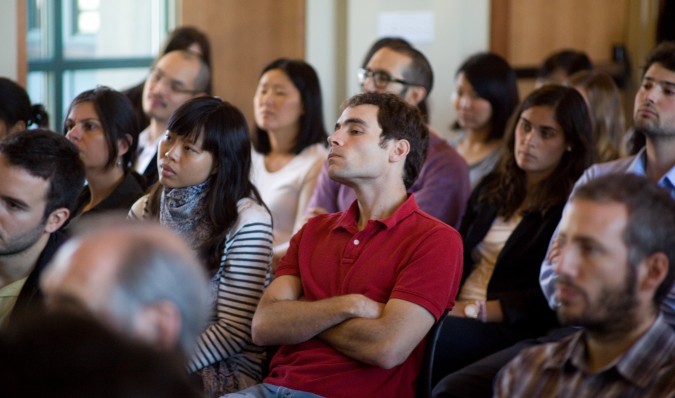
University of California Berkeley students listen to AT&T CEO and Chair Randall Stephenson speak, September 6, 2012
Stephenson said that 170,000 of AT&T’s employees actively participate in its TIP — The Innovation Pipeline — system conceived by the company’s CTO, a guy so tough to hire that it took ten years for Stephenson to do so. This system allows employees to propose ideas for the company to work on developing. People vote on the ideas and the best ones that float to the top are funded and pursued. In response to a question from a student in the audience, Stephenson said that apart from advertising the program to employees the company does little to promote participation. He said participation is quite good.
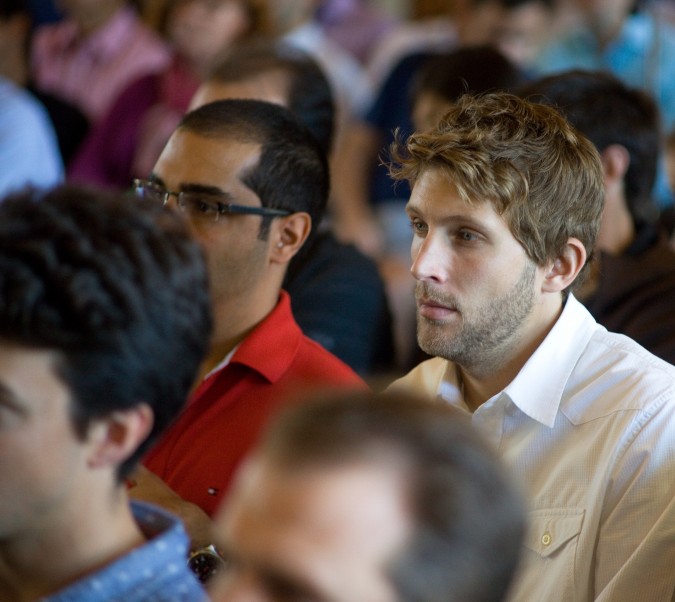
University of California Berkeley students listen to AT&T CEO and Chair Randall Stephenson speak, September 6, 2012
Stephenson and and his public relations person Larry (last name not mentioned) said they were so excited about a couple of their ‘tattooed up’ technologists in their Palo Alto, California research lab named the ‘Foundry’ that they put photographs of them in AT&T’s Annual Report. Stephenson divulged that competitors now are ‘coming after’ these programmers trying to hire them away from AT&T.

University of California Berkeley student asks AT&T CEO Randall Stephenson a question about AT&T's TIP suggestion system, September 6, 2012. Photograph by Kevin Warnock.
A student from the audience asked Stephenson to discuss wireless handset subsidies. Stephenson answered at length and concluded that the current system in the United States is overwhelmingly what customers want. He said AT&T performed studies where customers were asked if they would like to finance a phone via a separate finance contract, in exchange for markedly lower rates for service. Stephenson said customers did not like this proposal.
I think the survey respondents that answered this way are short sighted.
The way things operate in the United States, where one can buy a USD $700 iPhone for $200 because of the carrier subsidies, there is a perverse incentive to upgrade your phone exactly every two years. That is because contracts generally run for two years. If you keep a phone for three years, that final year you are paying much more than is warranted for service.
People should be encouraged to save money, not spend, so I admire the relatively new system reported by Stephenson to be the norm in Europe — phones are not subsidized and rates for service are [I hope] commensurately lower. Stephenson said phone sales dropped dramatically when this policy was implemented, but I say that is just what the world needs. People keep a home phone for decades. People keep televisions, stereos and other household appliances for years. Stephenson told me one-on-one after the event that fully 90% of his company’s customers upgrade their wireless phone every 14 months. Since contracts are two years long, 90% of its customers are paying early termination fees, which decline over time. That is a waste of the world’s resources, even in this day of a vibrant resale market for used mobile phones. I’m pretty sure a lot of people just throw their old mobile phones in a drawer, to benefit nobody. I understand mobile phones improve rapidly, and I do plan to get the latest iPhone when it’s available, having skipped the iPhone 4 and iPhone 4s. I just don’t approve of upgrading exceptionally frequently, which I consider 14 months to be.
I encourage AT&T and all carriers to offer unbundled rates for mobile service, as an option.
Rich Lyons is a good interviewer. The setting was photogenic — two handsome cushioned arm chairs on an elevated stage, with a small end table between the chairs. Lyons and Stephenson wore wireless lapel microphones. There was a backdrop behind the men that repeated the logos for UC Berkeley and the Haas School of Business, so the logos made it into every photograph of the people on stage. As a photographer, I applaud the Dean for creating such an inviting, warm and photogenic environment for his interviews. I look forward with enthusiasm to the next Dean’s Speaker Series interview, which I hope to be able to attend.
Former Haas Dean Dr. Laura D’Andrea Tyson is on the Board of Directors of AT&T, and presumably she helped Lyons recruit Stephenson to visit the Haas School. Tyson was Dean when I was a finalist in the Berkeley Business Plan Competition in 1999 with my company Hotpaper.
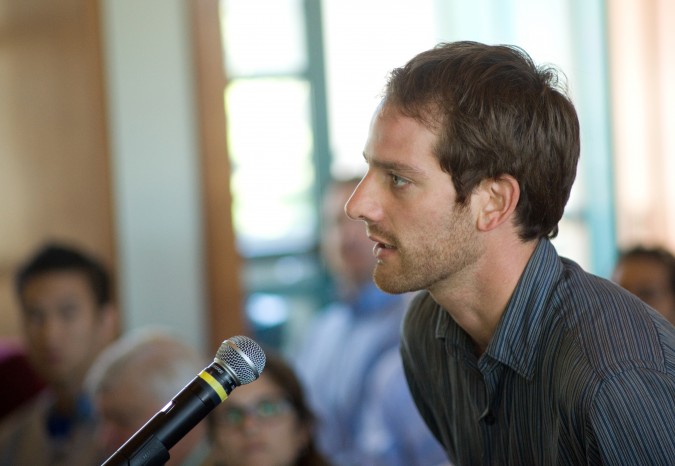
Student asks AT&T CEO and Chair Randall Stephenson a question about mobile handset subsidies, September 6, 2012, at University of California Berkeley
I took the photographs that accompany this blog post.
I used a Canon 5D Mark II camera with the following lenses: Canon 135mm soft-focus lens set to sharp, Canon 16-35mm L zoom lens. I upload pictures to this blog at maximum camera resolution at maximum image quality. Click on the photographs twice in delayed succession to see the full size images. If you would like to use these pictures, please send me a message. If the purpose is reasonable, I will allow usage. I enjoy having my pictures displayed elsewhere. I pursue photography only as a hobby, not as a profession.

At the end of his interview, Rich Lyons stands with ATT CEO and Chair Randall Stephenson at the Haas School of Business, September 6, 2012. Photograph by Kevin Warnock.
Finally, I have some advice for Berkeley students reading this post — introduce yourself to the speaker.
I don’t recall seeing any students introduce themselves to Stephenson. I did see a professor and a president of a good sized company say hello, but that’s it. Stephenson spent several minutes talking with me because there was nobody waiting after me to speak with him. The room had rapidly cleared out. The interview was during the lunch hour, so perhaps the students had to be in class immediately after. It’s rare for so prominent a CEO to speak to such a small group — there were about 140 students in the room by my quick count. I’m sure Stephenson won’t be back this academic year. Make a point of meeting all such prominent speakers. In my mind, Stephenson should have been surrounded by dozens of students trying to shake his hand. Stephenson didn’t appear to be in a rush to depart, and I left before he did.
I met with startup advisor John Matthesen, mentor to HARBO Technologies in the 2012 UC Berkeley Startup Competition
I enjoy blogging.
I am enjoying it more all the time for it affords me the opportunity to sit down and talk with interesting people.
When I covered the Berkeley Startup Competition (prior to 2012 known as The Berkeley Business Plan Competition) on April 26, 2012, I introduced myself to John Matthesen. Matthesen was assigned this year to mentor HARBO Technologies, which won the Energy and Clean Tech (archived version for use if previous link breaks in the future — 2012 Berkeley Startup Competition winners list) track of the competition with its innovative system to greatly reduce the environmental impact of oil spills in bodies of water.
I met Matthesen while I was waiting in line to introduce myself to HARBO’s CEO Boaz Ur.
I told both Ur and Metthesen that I’d like to interview HARBO for my blog. Since HARBO has invented new technology, they’re not yet ready for press coverage, as they’re still working on the legal issues, Matthesen explained by email. But he said I could interview him individually so long as we didn’t discuss HARBO. Matthesen struck me as an interesting guy I should meet in any event, so I took him up on his offer.
I met John Matthesen for coffee at the trendy ZEB Cafe at the University of California Berkeley Law School at 2745 Bancroft Way, Berkeley, California USA. According to Matthesen’s website for his company Related Concepts, he helps companies with interim management, qualitative customer research, business process development, team building and coaching, and finally, board of directors / advisory boards. I confined my questions to his background and his work as a mentor.
We jumped around to a lot of topics, never really finding a theme for this post — it didn’t seem right to talk about the past companies he’s mentored for the Berkeley Startup Competition without getting the permission from those teams.
I do feel comfortable saying that two years ago Matthesen was mentor to the winner of the 2010 Products & Services Track, BrightSense, which, according the Berkeley competition’s website:
“… uses a novel patent-pending drug delivery technology to design customized whitening strips with peroxide dosages optimized for each user’s teeth.”
There is more information about BrightSense in the University of California 2010 Berkeley Business Plan Competition booklet.
Matthesen has been fortunate to advise two winning teams.
I asked Matthesen how he got to be asked to be a mentor in the Berkeley Startup Competition. He wasn’t sure, but speculated it had to do with his background at Sybase and Commerce One.
Matthesen was an early employee at Sybase, one of the early pioneers in the database market. Microsoft licensed Sybase to form the basis of Microsoft SQL Server, still Microsoft’s sole enterprise database product. Matthesen had worked in Information Technology role at a hotel in Hawaii, and the hours were brutal. The hours Sybase told its new hires they would be expected to work were long as well, but less intense that what he endured in Hawaii. Matthesen intended to stay at Sybase just 6 months, but instead stayed for 7 years, through their initial public offering of stock. Sybase today is owned by SAP.
After Sybase, Matthesen went to Commerce One, early enough to ride the first dot com boom up to its height, and for long enough to witness the carnage of the boom’s aftermath — another seven years.
After 14 years of intensity at Sybase and Commerce One, Matthesen was ready for a break, so he turned down an early job at Google, which sadly presumably cost him millions of dollars. Ouch!
I asked Mattesen if he knew David Henderson, but he didn’t. I hired Henderson to work with me for a little over a year at my first Internet company, Hotpaper.com, Inc., and his next job was at Commerce One.
While researching this post, I discovered that Commerce One is still in business, though it’s an invisible shadow of its former self. Congratulations to the team for staying in business given the turmoil along the way.
Matthesen entertained me with crazy stories of the stock price of Commerce One shooting past USD $1,000 per share and then collapsing to zero. Matthesen advised the Commerce One CEO to ‘buy something big’ of real value, but his advice was rebuffed. The companies Commerce One could have bought at the peak of its power as a public company are still large household names deeply embedded into the daily fabric of the planet.
Matthesen told me he managed his personal finances during that crazy boom time such that he could pay his Alternative Minimum Tax bill, when his colleagues and friends were going bankrupt over their huge AMT bills in the many millions of dollars.
Young entrepreneurs in today’s boom may not be familiar with how unfair United States tax policy was during the first boom. If one exercised stock options but didn’t sell the stock right away, there was a big risk that the stock would go down by the time you sold the stock. The AMT tax was applied to the paper gain you made when you exercised the stock, and if the stock collapsed before you could sell it, you still owed tax on the paper gain. Think of the devastation if you had a USD $100,000,000 paper gain and the stock dropped to zero before you sold it. You would owe AMT tax on the $100,000,000 even though you never touched the cash.
I haven’t paid much attention recently to this AMT trap, and I never got caught in it when I sold Hotpaper, as I never held options, just common stock.
I learned from Matthesen that the AMT trap in 2009 was partly fixed, retroactively. People who were ensnared in the early 2000s were able to apply for relief and get huge sums back from the United States Treasury.
I don’t want to take on the responsibility to accurately summarize the tax relief, so I direct you to this article on the subject.
I spoke with Matthesen for less than an hour, and mostly we shared war stories. After I interview Boaz Ur of HARBO, I’ll likely have more to say. Until then, have a look at the pictures I took of Matthesen at the conclusion of our conversation, above.
13th Annual UC Berkeley Business Plan Competition results
For posterity, here’s the email that University of California at Berkeley sent out notifying recipients about the winners of the 2011 Berkeley Business Plan Competition.
The finals were held at the Berkeley Entrepreneurs Forum today, April 28, 2011.
Since the online version of the email probably won’t stay online forever, I made a screen capture of the email, below.
An .edu inbound link for this blog, but I’m not Overstock.com!
I was a contestant in the first UC Berkeley Business Plan Competition, which happened in 1999. My company didn’t win anything, but it was still a remarkable experience that changed my life. Because I am so grateful, I have sponsored the competition yearly for the dozen years since. Usually the competition just lists the sponsors, but doesn’t link to them. This year all the sponsors got links! And, to make it even better, all the sponsors are listed on the front page of the bplan.berkeley.edu website. I’m getting daily traffic to this blog from that link… not enough to get me in hot water with Google like what recently happened to Overstock.
I’m happy to be recognized, and I’m happy to help the competition help others move their ideas forward. This year over 200 teams applied, a record. I encourage you to attend the public awards ceremony at 6pm on April 28, 2011 at the Haas School of Business in the Anderson Auditorium.
